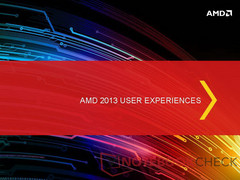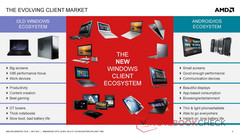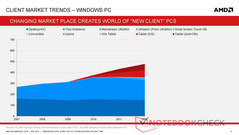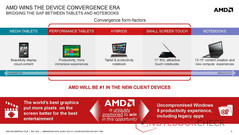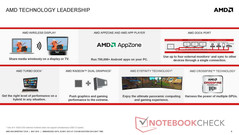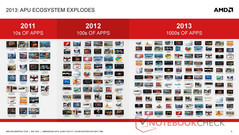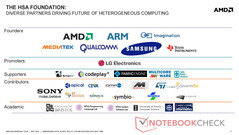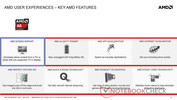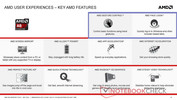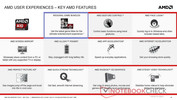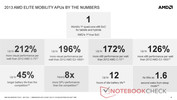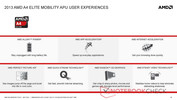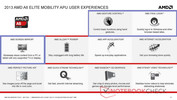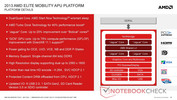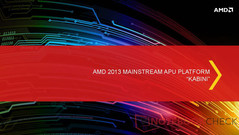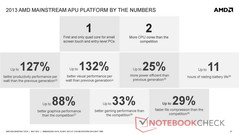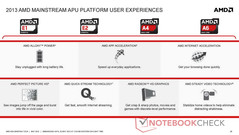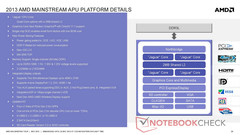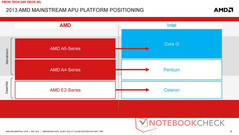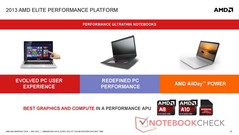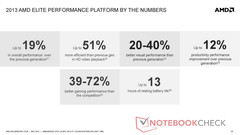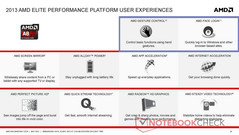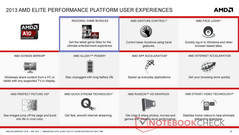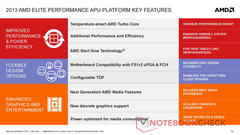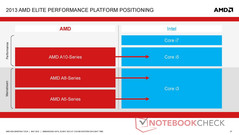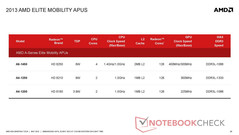‘More power with less fuel consumption’ appears to be AMD’s motto for processors going into next generation mobile computing devices. The new APUs are designed for entry-level and small form factor touch notebooks, tablets, hybrid devices, and premium ultrathin notebooks.
Many of AMD’s new APUs are positioned to fill the gap between tablets and conventional 13 to 15-inch notebooks. However, it also looks like the company is particularly interested in slotting Kabini and Temash into the booming device market of powerful tablets and hybrid ultraportable notebooks with touch screens.
For a taster of how well AMD manages to live up to the company’s own high expectations check out our test of the Temash A6-1450 APU. The test device is an Acer Aspire V5-122P 11.6-inch subnotebook whose SoC integrates a Radeon HD 8250 GPU. You will also find a short test for the Kabini A4-5000 APU here.
AMD describes its new APUs (Kabini for notebooks and Temash for tablets) as a ‘true SoC design’, since the memory controllers (single-channel, DDR3-1600) and Southbridge are both integrated. Kabini and Temash are both based on the same chip architecture and are the successors of Hondo, Zacate, and Ontario.
Temash is AMD’s “ultra-low power platform” with TDPs ranging from 3.9 to 9-Watts designed for touch-enabled small form-factor notebooks, tablets, and hybrids below 13-inches. In addition to Temash’s low power consumption, AMD is also touting graphics performance claiming: “Best graphics experience of any SoC on the planet for touch tablets, hybrids, and notebooks.”
The new Jaguar-based dual and quad-core CPUs are up 20 percent faster than their predecessor, Bobcat. Tablets with an A6-1450 APU can also enjoy up to a 40 percent performance boost when used in conjunction with AMD’s Turbo Dock. Temash also supports up to 2x USB 3.0 ports and up to 10x USB 2.0 ports.
AMD has positioned its Elite Mobility A4-1200 (HD 8180), A4-1250 (HD 8210), and A6-1450 (HD 8250) APUs for tablets and hybrids, between Intel's Atom SoCs and Core i3. On the notebook front, Temash is gunning for Intel’s Celeron and Pentium processors.
AMD’s Mainstream APU (formerly codenamed “Kabini”) will address small screen touch-enabled notebook designs as well as entry-level notebooks. With TDPs from 9 to 25 Watts the new APUs provide manufacturers with ‘best-in-class graphics and first-in-class x86 quad-core SoC’.
Kabini APUs consist of the A-Series A4-5000 (HD 8330) and A6-5200 (HD 8400), and the E-Series E1-2100 (HD 8210), E1-2500 (HD 8240) and E2-3000 (HD 8280). A-Series parts are quad-core, while all E-Series parts are dual-core. The A6 APUs are expected to directly compete with current Intel Core i3 offerings, while the A4 series goes up against Intel’s Pentium line-up, and AMD's E2 APUs which should outpace Intel’s Celeron silicon.
In addition to Kabini and Temash, AMD is now offering a total of 7 new Elite Performance APUs (formerly codenamed “Richland”) that according to the company “offer the best graphics and compute in a performance APU for premium ultrathin notebooks”.
Richland APUs were announced more than a couple of months ago and currently consist of three 35W parts (the A10-5757M, A8-5557M and A6-5357M) and 4 new ULV APUs (A10-5745M, A8-5545M, A6-5345M and A4-5145M).


 Deutsch
Deutsch English
English Español
Español Français
Français Italiano
Italiano Nederlands
Nederlands Polski
Polski Português
Português Русский
Русский Türkçe
Türkçe Svenska
Svenska Chinese
Chinese Magyar
Magyar